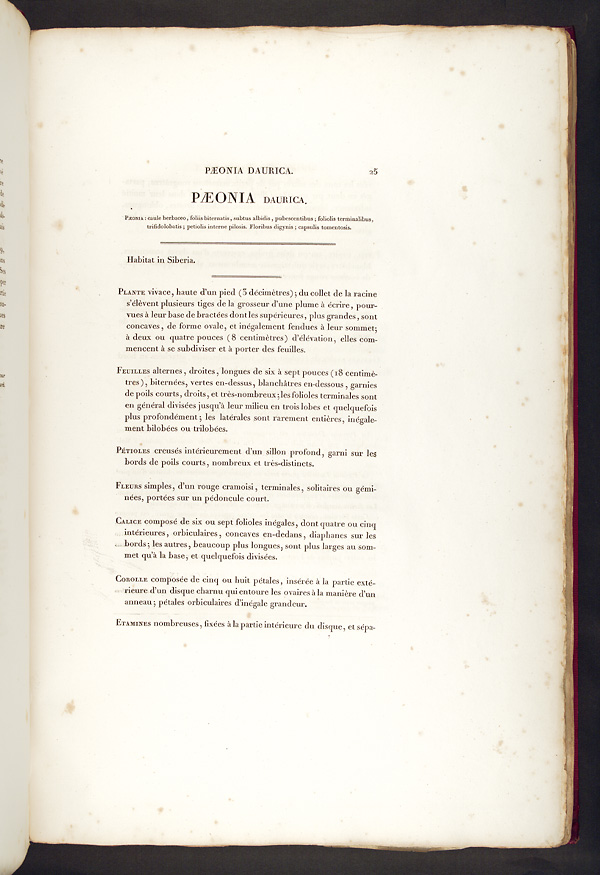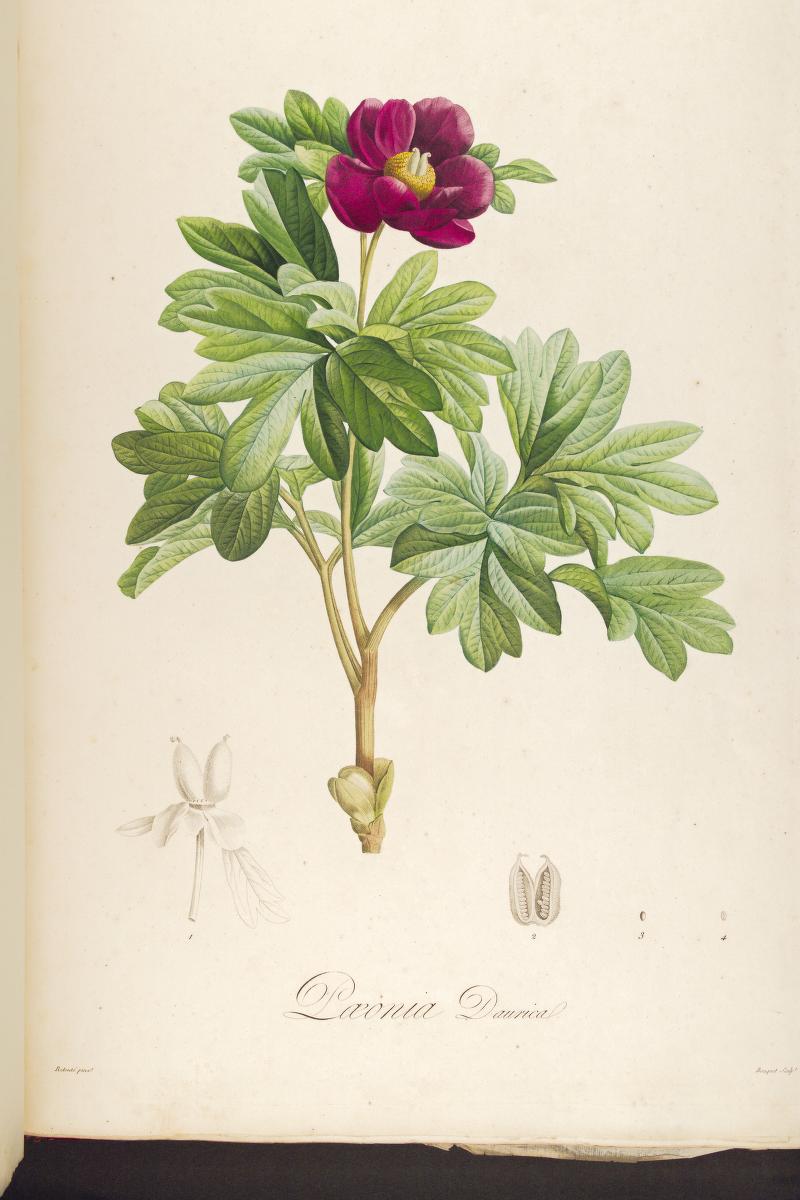accepted name (2005):
accepted, but in a broader sense, see Hong 2003
Description des plantes rares cultivées à Malmaison et à Navarre / par Aimé Bonpland.
Author: Bonpland, Aimé
Publisher: Paris : De l'Impr. de P. Didot l'aîné, 1813 [i.e., 1812-1817]
Paeonia pages: 9-12, 33-34, 69, 122-123 + plates
complete book is available online under http://www.illustratedgarden.org/mobot/rarebooks/library.asp?relation=SB4046F8B66181217



1818
Anderson see the reference of Baker below
1884
19. P. triternata, Pallas, Nov. Act. Petrop., x., 312 ; DC., Prodr., i., 65 ; Ledeb., Fl. Ross., i., 73. P. corallina var. triternata, Boiss., Fl. Orient., i., 97. P. daurica, Andr. , Bot. Rep., t. 486; Bot. Mag., t 1441; Anders., Monogr., No. 7.—Root -tubers thick. Stem 1 ½ —2 feet long, glabrous, never more than 1-flowered, Leaves 5—6 to a stem, glabrous, pale green above, glaucous beneath, with broad oblong or obovate leaflets, obtusely rounded at the apex, with a small cusp, not confluent at the base, the side ones often a inches broad, and the end one obovate or orbicular, 3—4 inches long and broad. Outer sepals foliaceous; inner obtuse. Petals 6—8, obovate, rose-red, 2—2 1/2 inches long. Follicles 2—4, densely tomentose, spreading from the base when mature; stigmas small, ovate, folded together, recurved. A native of the Caucasus, Asia Minor, and the Crimea. It is a near ally of P. corallina, with which Boissier now unites it. The name daurica, under which Anderson describes it, was given to it under a mistake as to its native country. Anderson remarks upon it, " Though in general habit a good deal resembling P. corallina, it is nevertheless essentially distinct from that species in having the leaves always rounded, partially cordate, oblique and much undulated ; whereas those of the former arc more or less pointed, and nearly flat, the spherical, brownish-black, reticulated seeds, and the yellow tint of its leaves, stalks and germens, would otherwise characterise it. Its leaves are diposed to wither at the points, and to remain longer on the stalks than those of the others. Its Sower is of a pleasant pale rose colour. Amongst seedlings it is seen to vary in the degree of undulation of its leaves, but retains its essential character throughout."
1946
1961
Wister
P. daurica Andrews, 1807.
Synonyms: caucasica Schipczmsky, 1937; corallina Retzius sec. Bieberstein, 1808; corallina subsp. tritemata (Pallas) Busch, 1901; corallina subsp. triternata var. corifolia (Ruprecht) Busch, 1901; corallina var. caucasica Schipczinsky, 1921; corallina var. pallasi Huth, 1891; corallina var. tritemata (Pallas) Boissier, 1867; mascula var. tritemata (Pallas) Gurke, 1903; tritemata Pallas, 1795; and tritemata t. coriifolia Ruprecht, 1869.
Crimea and Caucasus. Best known in gardens as "tritemata" Pallas. Distinguished by ruffled rounded upturned leaves. Probably discovered by Pallas before 1790 and sent to Bell in London. This is the original name under which it has long been known in gardens. Only recently, apparently, has it been noted that it was a nomen nudum, that is, a name without a valid description. Under botanical rules, therefore, it has no standing. For that reason Stern has accepted the next oldest name daurica. Stebbins considered "tritemata" the species of which mlokosewitschi was only a botanical variety, but Stern does not agree and places it in the mascula group. It was listed by Barr in 1885. Flowers rose or magenta to soft pink.
1961
Kemularia-Nathadse
Paeonia triternata Pall.
Pallas in Nova Acta Acad. Petrop. X (1975) 312; DC. Prod. I (1824) 65; Ledeb. Fl. Ross. I (1842) 73; Rupr. Fl. Cauc. (1869) 44; Lipsky Fl. Cauc. (1899) 213; Somm. et Lev. Enum. (1900) 29; Komarov and Schipczin. in Fl. USSR. VII (1937) 28;
Syn. .... P. daurica Andrews. Bot. rep. 7 (1807) 486; Anders. Mag. (1812) 1841. Stem, Monogr. Royal Horticult. Soc. (1946) 70;....
1965
Davis & Cullen in Flora of Turkey
P. daurica Andrews in Bot. Rep. 7: t. 486 (1807). Syn: P. triternata Pallas in Nov. Act. Petrop. 10: 312 (1792); P. corallina var. triternata (Pall.) Boiss., Fl. Or. 1: 97 (1867).
1983
1984
Stearn & Davis
3e. P. mascula subsp. triternata Figs 33,34
P. daurica Andrews, Bot. Repos. 7: t. 486 (1807); Sims in Curtis's Bot-Mag. 35: t. 1441 (1812); F.C. Stern, Study of Paeonia, 70, t. 6 (1946); Cullen & Heywood in Fl. Europ. 1:243 (1964).
P. triternata Pallas ex DC., Prodr. 1:165 (1824), nomen illegit.
P. corallina var. triternata Boiss., Fl. Orient. 1:97 (1867).
P. corallina subsp. triternata (Boiss.) N. Busch in Kusnezow, Busch & Fomin, Fl. Cauc. Crit. 3.ili:10 (1901).
P. mascula var. triternata (Boiss.) Gürke in Richter, Pl. Europ. 2:400 (1903).
1986
1988
1993
Cullen & Heywood in Tutin: Flora Europaea
(b) Subsp. triternata (Pallas ex DC.) Stearn & P. H. Davis, Peonies of Greece 107 (1984) (P. triternata Pallas ex DC., P. daurica Andrews, P. taurica auct.): Leaves glabrous beneath; leaflets usually 9, broadly ovate to suborbicular, with undulate margins. Flowers pale purplish-red. Filaments yellow. Follicles 2 or 3. Romania; Krym.
published in:
Hong D Y & Zhou S L, 2003: Paeonia (Paeoniaceae) in the Caucasus. Bot. J. Linn. Soc. 143: 135—150. [Abstract: The taxonomy of the genus Paeonia in the Caucasus has been controversial, with recognized species varying in number from one to 13. The taxonomic history of Paeonia in this area is reviewed (including an analysis of the characters used by previous authors) based on extensive field observations, population sampling and critical examination of a large number of herbarium specimens. The results show that Paeonia may be divided into three groups. The P. intermedia group is known from only a single population. In the P. tenuifolia group, all the characters used for distinguishing the three previously recognized species were found to be polymorphic. In the P. daurica group, petal colour, shape and size of leaflets, and indumentum of leaflets and carpels were used to distinguish nine species, but these characters were found to be polymorphic or continuous in variation, and thus can only be used for infraspecific classification. Thus, three species are recognized: P. intermedia, P. tenuifolia and P. daurica. The last species is further divided into five subspecies: sspp. coriifolia, wittmanniana, mlokosewitschii, macrophylla and tomentosa stat. nov. © 2003 The Linnean Society of London, Botanical Journal of the Linnean Society, 2003, 143, 135-150.] (link to a local copy .pdf-file)



















